Menu
I received quite a few questions asking about the most effective way to stop climate change, and how kids can be part of the solution. As you probably know, the key thing that we need to do to help stop climate change is to stop emitting greenhouse gases – particularly carbon dioxide and methane. There are things we can all do to help with this, like driving less, using renewable energy, or tyring to eat local produce that doesn’t have to be transported to Tasmania from far away. But for the really big changes to greenhouse gas emissions that are required to help stop climate change we need our governments to implement policy change. The more we all call for these changes – as a community – the stronger our message to politicians will be.
Another thing we will need to do to help stop climate change is to actively remove carbon dioxide from the atmosphere. There are lots of ways to do this, but some of the simplest and most effective are those that harness the power of nature. Planting more trees, leaving coastal and marine habitats like mangrove forests, seagrass meadows and kelp forests intact. If you’re interested in engineering then there are also some very cool technologies emerging that will help us to pump carbon dioxide out of the atmosphere and back under the ground.

The future of Tasmania and of our planet belongs to kids of today, not to grown ups. Kids ask great questions and they are fantastic at thinking up new ways to solve problems. I think that one of the most important things that kids can do is to keep asking questions and to keep learning to be problem solvers. Keep being curious and caring about climate change!
This is an important question because if we know how climate change affects these environments, we can identify ways to prevent further damage and to help these environments to bounce back. But before we dive into the how, check out this question 'will all the reefs die?'
It’s good to remember that not all reefs will be destroyed! However, climate change is increasing water temperatures and acidity which impacts the species that call reefs and trenches home.
In tropical coral reefs, warmer waters, heatwaves, freshwater flooding events, and changes in nutrients from pollution cause coral bleaching. Corals are skeletons, built from calcium and carbonate from the water around them, and are home to algae which provide nutrients to keep the coral healthy and gives the coral a brown/golden colour. When the water is too warm, the relationship between coral and algae breaks down and the stressed coral expels the algae, meaning it loses its primary food source and colour - this is known as coral bleaching. Corals are also changing in response to another impact of climate change, called ocean acidification, where the pH of the water lowers as the ocean absorbs carbon dioxide. This makes calcium minerals less available to animals including corals, that need these minerals to grow shells or skeletons. Unhealthy coral is also stressful for other species that depend on the reef for food and shelter.
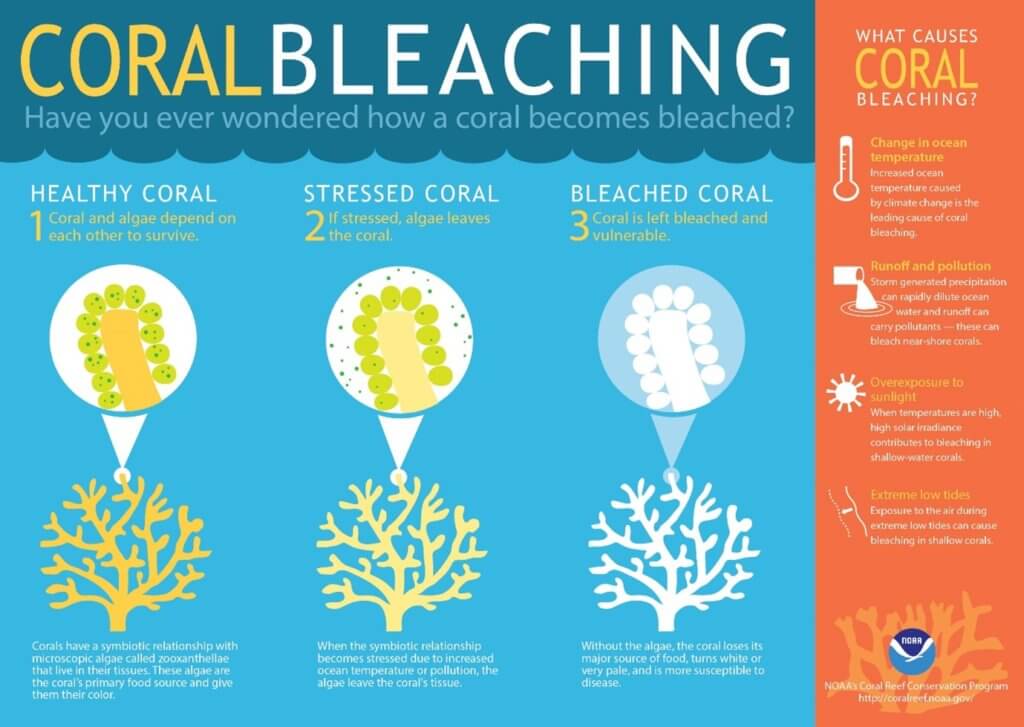
To hear more about coral reefs (and how jellyfish move!), have a listen to this episode of the Dr Karl Podcast where the Chief Scientist of the Great Barrier Reef Marine Park Authority explains how climate change is affecting the Great Barrier Reef.
In temperate reefs (with kelp and seaweeds) increased water temperatures with lower nutrients are preventing some species from growing and encouraging other species to evolve or move. Off Tasmania’s east coast, the warm waters of the East Australian Current have been moving south, reducing the giant kelp and introducing other species usually found in places with warmer climates. To help restore the reefs, researchers at the University of Tasmania have been successful in planting kelp that is more resistant to warmer temperatures - check out this video for more details.
Deep sea trenches are also experiencing increased temperatures and ocean acidification. Some deep-sea trench dwelling species will be unable to adapt to these changes, whereas other species may move into these environments. Deep sea trenches and their species recycle and channel nutrients back to the surface, and changes in these environments is likely to have flow on effects across the whole water column (from the seafloor to the surface). Extra human pressures from pollution, deep sea drilling for oil and gas, mining and fishing will add further stress to these environments. Limiting human activities in the deep sea will give these creatures the best chance to adapt to change, and right now, the United Nations are currently discussing an agreement known as the Treaty for Marine Biodiversity of Areas Beyond National Jurisdiction, to improve ocean management and increase protection.
Climate change affects the earth in many and complex ways. Much research attention is currently being directed towards the influence of climate change on biodiversity both on land and in the oceans.
You’ve likely seen discussion about coral bleaching on our own Great Barrier Reef. Research from the IPCC (Intergovernmental Panel on Climate Change) shows that with global temperature rise of 1.5°C, 70-90% of coral reefs will be lost. With a rise of 2°C, 99% percent will be lost. Along with coral loss will come the degradation or loss of whole reef ecosystems and the species evolved to live in them.
The oceans have absorbed around a third to a half of carbon dioxide released into the atmosphere through human activity since the 1850s. This process is changing the pH of ocean water, making it more acidic. Research shows that there has been a 26% increase in ocean acidity since the 1850s – which is about 10 times faster than at any time in the last 55 million years. Ocean acidification makes carbonate less available in sea water and as this is the building block of the shells and skeletons of many marine organisms, it has negative consequences for many marine organisms. Molluscs and some species of plankton are particularly affected. Ocean acidification also further weakens coral, making it more vulnerable to destruction in storms. Some species may benefit: some algae and sea grasses may increase their growth rates. This image summarises how some key marine organisms will likely be impacted:
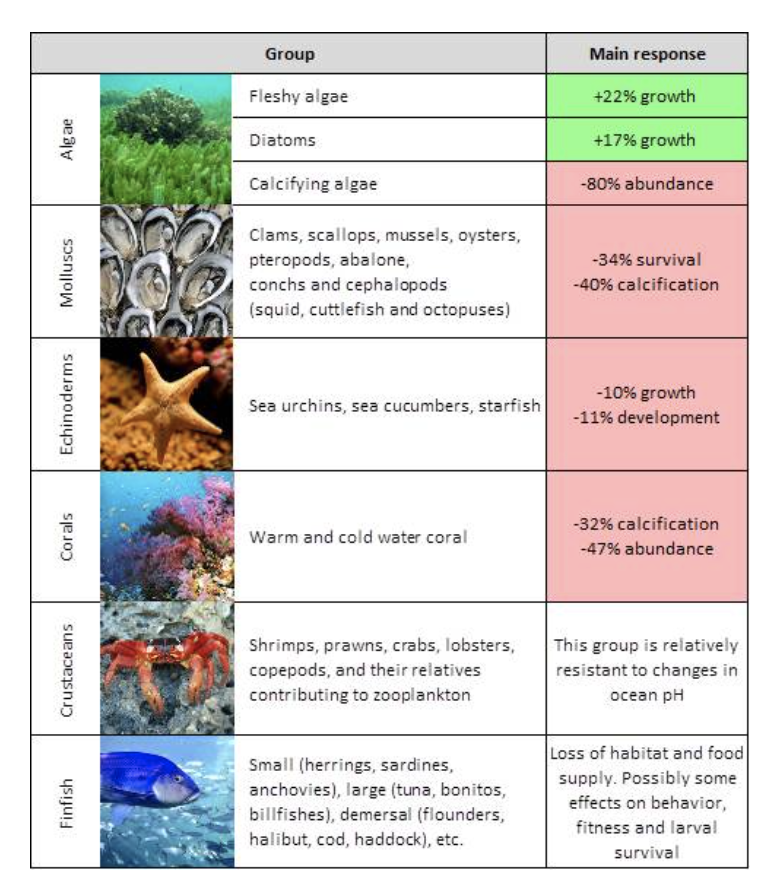
On land, climate change impacts on ecosystems are already widespread. One of the most visible may be the loss of millions of hectares of pine forest in British Colombia in Canada since the 1990s. This widespread damage has been caused by an insect called the Mountain pine beetle (Dendroctonous ponderosae). Normally kept in check by cold winter temperatures, the beetle has been able to survive winters that have recently become warmer due to climate change and has killed trees across vast areas.
In other places, species that are adapted to cool alpine or temperate environments move up towards mountaintops as temperatures warm – however, when they reach mountain summits, there is nowhere else for them to go. One example of this is the White lemuroid ringtail possum (Hemibelideus lemuroides) which lives only in the high altitude Daintree cloud forests here in Australia and is now only found on a few isolated mountain tops. It’s unable to survive temperatures above 30°C for very long.
Of course, animals that rely on ice, for example, Polar bears and Ringed seals in the Arctic, and Emperor penguins in the Antarctic, will be increasingly threatened as ice melts. A recent study has warned that almost all Emperor penguins in Antarctica will die out if no changes are made to greenhouse gas emissions.
The situation for the planet’s biodiversity is certainly very precarious and confronting – however, these losses are not inevitable. Science tells us that if we can work globally to limit greenhouse gas emissions quickly and dramatically, we would see a stabilisation of temperatures within 20-30 years. Restoring natural habitats has been identified as one way to both protect biodiversity and store carbon – a win-win for local biodiversity and the planet as a whole. Reducing emissions and restoring habitats (sometimes called “rewilding”) are essential now to protect the remarkable biodiversity of planet Earth.
This is such an interesting question, because of all the different connections between the climate and our behaviour that feedback on each other. The climate is always changing and events like volcano eruptions and heatwaves can impact the climate the climate. Dramatic events can also be socially driven and have an impact on climate, like wars, or COVID-19. That’s because humans are part of the ecosystem and what we do has ripple effects on everything else, especially because there are so many of us now! The world population is over 8 billion people. So how we live, the gases we produce in our transport and food production and the way we change landscapes, removing trees and building large concrete structures can impact the way heat is absorbed and feedback into the climate system.
Although it might not seem as dramatic as a volcano or war, climate change is different to these other types of climate influences, because it is so persistent. It is also getting faster. It’s a bit like falling over compared to rolling down a hill. Collectively, humans add up to a big influence on the gases in the atmosphere that cause climate change. The way we live is increasingly fast paced and impactful, so like gathering speed as we roll down the hill, unless we change our lifestyles, our impacts will continue to trend up rather than slow down. By comparison, other dramatic climate events are just a pebble in our path.
For more information, and a cool graph of how the temperature on Earth has changed over millions of years, check out the answer to ‘Why is climate change a problem if climate has constantly changed in the past?’.
Forests are habitats that are dominated by trees, these being plants that are woody and generally above 2 metres in height. The trees are dominant in the forest, but there are also the other smaller plants such as shrubs, herbs and ferns that form the ‘understorey’ of the forest (i.e. ‘under’ the canopy-forming trees). Then there are also the organisms that live in the soil, both above and below. These include countless number of invertebrates that live on the forest floor, both amidst the forest litter, made of debris such as leaves, bark, twigs and flowers/seeds, and in the soil (imagine some of the insects that live your garden soil!). And let us not forget the larger animals that also live in and depend on the forests, such as some of our mammals and birds.
The process of deforestation involves clearing of the forest (hence the ‘de’ in it!). The clearing mainly targets the trees in the case of forestry which involves growing and re-growing of trees so we can harvest the timber form the trees for various uses (e.g. building, paper-making). In other cases, such as happened in large parts of Australia and in other parts of the world such as the Amazon forests, clearing involves completely removing the trees, understorey plants, debris etc. to make way for other land uses such as producing food and fuels. Deforestation also occurs widely to make way for housing developments and associated infrastructure. These distinctions are useful as depending on the reason and nature of deforestation, and what aspects of the forests are cleared, the impacts on the atmosphere (and biodiversity) varies.
For example, if deforestation involves clearing of the trees, other plants and the debris, making way for houses and roads, all of the carbon stored in the landscape (both above and below the ground) is now potentially released back into the atmosphere thereby adding to our historic global greenhouse gas (GHG) emissions. Furthermore, by replacing a functioning forest habitat with a housing sub-division, the ability for those trees and other organisms to continue to take carbon away from the atmosphere and store it in the form of wood and other biomass has been compromised. Within forestry, depending on the nature of forestry practices, again large amounts of carbon can be lost into the atmosphere (where it is causing us harm) and also lost is our ongoing ability to remove harmful pollutants from the atmosphere and store it safely in the form of forest carbon.
The solution therefore is to manage our forestry practices in such a way to provide a net sink (not source) of carbon dioxide (which is a GHG). In other landscapes, the more we can integrate trees and other plants in creative ways, the more we can help remove carbon dioxide from the atmosphere, and also help us cool our cities, bring back birds to our backyards, and gain other benefits of experiencing nature in our daily lives.
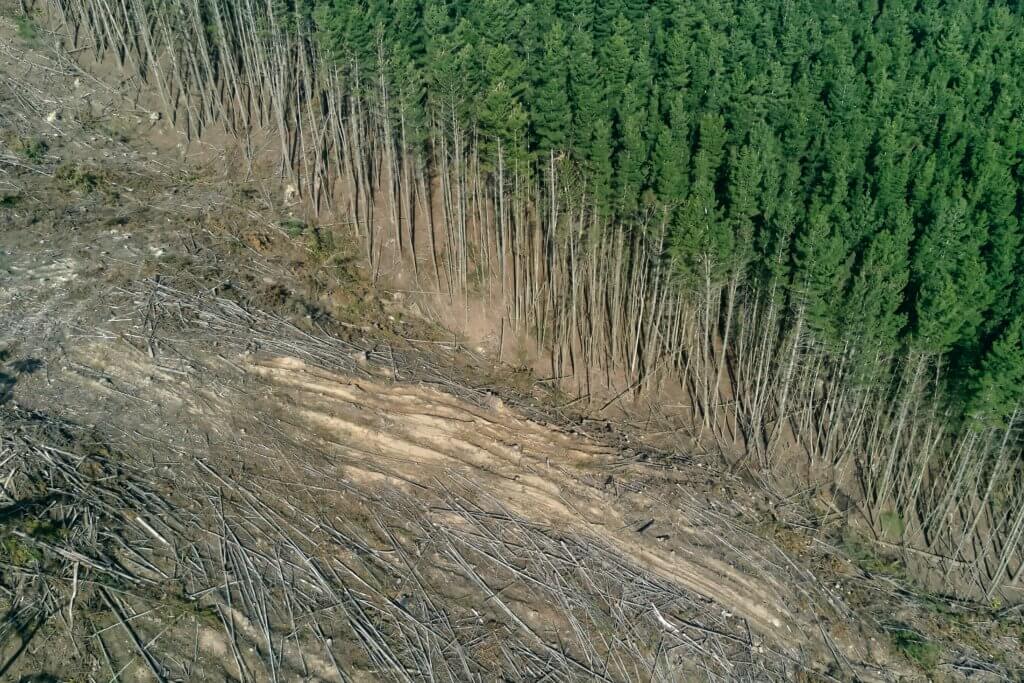
Microplastics are described as any plastic that is less than 5mm in size. Interestingly there are two types of microplastics, primary and secondary.
Primary microplastics are plastic items that are manufactured to be very small. For example, microbeads are tiny balls of plastic that can be found in personal hygiene products such as face scrubs, soaps, and toothpaste. Microfibers are tiny strands of plastic that are used to make clothing such as polar fleece jumpers.

Secondary microplastics are a result of larger plastic items breaking down into smaller and smaller pieces. For example, a plastic bottle breaking down into smaller fragments of plastic or a Styrofoam box breaking into smaller pieces. The breakdown of large plastic items into microplastics are caused by weather weakening the material, and other objects scraping and breaking the larger plastic objects.

The food sector is a big contributor to greenhouse gases. Globally, a third of emissions come from the systems we use to produce, package and distribute food.
Think about all of the energy needed to power the machinery on farms, in factories, to transport food and to store it. This energy is almost all from fossil fuels so that is a big problem and an immediate thing to address, we could reduce emissions hugely if we switched to renewable energy.
As much as 10% of the food produced is wasted and food waste is another cause of emissions. The food sector is therefore a big part of greenhouse gas emissions and one that we can work towards improving, through reducing energy use, changing to renewables, and changing diets to reduce foods that take a lot of energy and inputs to produce, like meat.
We can also work to improve efficiency and energy use in our transport systems and reduce waste. The food sector is one of the most exciting areas to address climate change because there are lots of things that can be done and that can have positive benefits to, like reducing hunger or making food healthier. Things like supporting more locally produced and distributed food, not buying imported foods, supporting less packaging and less intensively produced food and reducing food waste.
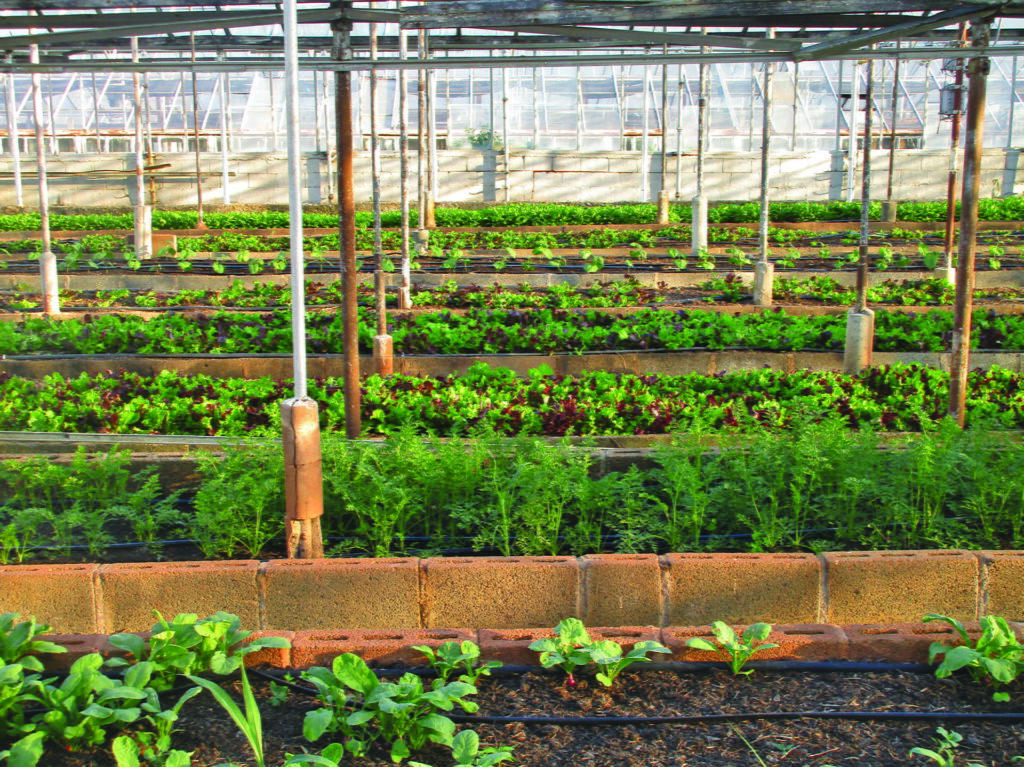
Supermarkets are big players in this and are starting to think about how to be more sustainable and reduce waste. These are exciting developments and consumer demand has been a big part of this. So keep the pressure on! Thinking about what you eat and how it was produced and supporting the food producers who are doing their best to reduce emissions and producing locally is the best way to combat climate change.
When organic waste decomposes, carbon dioxide and methane gas is created. Methane is created when there is no air present, while carbon dioxide is the natural product when anything rots in air. So, basically – methane is produced when food goes to landfill, and carbon dioxide is produced when food is composted. As you probably know, carbon dioxide and methane are both greenhouse gases that are responsible for climate change. But methane is more than 25 times as potent as carbon dioxide at trapping heat in the atmosphere. So composting is better than sending food waste to the tip, but a better solution is for us to minimise food waste wherever we can.
The production and disposal of other types of waste also produces greenhouse gases, because these processes use natural resources such as water and fuel. Plastic waste produces greenhouse gas emissions during every stage of its lifecycle. The production and transport of plastic is dependent on oil, gas, and coal and so releases carbon dioxide into the atmosphere. In fact, waste management in general – including transportation, incineration, and other processing – is a huge contributor to greenhouse gas emissions.
Climate change is already affecting ecosystems in our oceans and on land, all around the world. In many cases these effects are negative ones, such as the impact of ocean warming and acidification on coral reefs, or the effects of changing ocean temperatures on the loss of giant kelp forests off the east coast of Tasmania. Loss of key species like kelp, or groups of species like corals, can have flow-on effects to many other species that depend on them for habitat or food, and so can quite quickly cause ecosystems to change completely.
However, not all species or ecosystems are negatively affected by climate change. There are some winners as well as losers. One of the most noticeable ecological effects of climate change that we are seeing in the oceans and on land is large-scale movement of species as their habitats warm and they move (if they can) to follow the location of their preferred habitat. But of course not all species can move. Some might have limits to how far they can move (for example up a mountain), or they may not be able to move fast enough to keep up with warming temperatures.
There are lots of things that we can do to help species and ecosystems adapt to the effects of climate change. Because the Earth’s climate is changing so quickly we may need to help some species by speeding up their rate of evolution. We can reduce the number of other human impacts – like pollution or fishing – so that species and ecosystems are less vulnerable to the effects of climate change. We may be able to use technological interventions to help some species or ecosystems adapt, such as relocating them or providing them with artificial substrates.
There are so many kinds of living things in the world, each one different from the next. An ant is entirely different from and octopus, a shark is different from a wallaby, you and I are different from a snail. But there is one very important thing we all have in common. We all have an environment in which we can best live and grow and we are always learning from it. This environment not only provides important things like the right amount of sunlight, the right amount of warmth and oxygen in the air, it also provides the right kind of food and right amount of water and, the necessary level of chemicals in the soil.
The environment is always changing, that is the way of the world, and all living things learn from their environment and change themselves to become better able to live in it. Some living things are more flexible than others, they can live in a lot of different temperatures for instance or eat different kinds of food. A lot of living things, though, are very specific. Corals for example are very picky when it comes to how warm or cool their waters are. Koala bears are the same – they only eat a few different kinds of eucalyptus leaves. This is why corals only grow in certain areas of the world, and koala bears only live in Australia. Given time, corals could perhaps learn to live in warmer or cooler temperatures, and Koala bears might learn to eat other leaves. Or they could even evolve into entirely different species that can do these things. If they do change (or adapt) or evolve will depend on a great many things, but if they had the time to and their environment demanded it, it is entirely possible.
The problem with climate change, though, is that the changes are happening too fast, and most plants and animals don’t have enough time to learn and change to their environment. It’s like being told to run a 5k marathon without having had any training. You won’t make quite make it; but given time, and training you learn, your muscles get stronger, your stamina builds… your body changes into one that is able to run a marathon. Everything needs time.
In Tasmania, we have seen a lot of change in the oceans. As a result of Climate Change the ocean waters have become much warmer, and not only that they have less of the good things like nutrients that sea animals and plants need to live. To survive, many fish and other sea creatures (more than a 100 species!) in Tasmania have moved away from our seas looking for environments further south that are cooler and more like the environment they are used to. Other species though have not been so adaptable. Along the east coast of Tasmania there used to be a massive forest of giant kelp (seaweed). A lot of sea animals used to call this forest home, but because seaweed is less able to move away like fish can, the entire forest is now almost completely gone. It became too warm for the kelp to live and without the time they needed to change and become more used to the warmer waters, the forest has nearly died out in these parts. Without the protection and shelter that the kelp gave them, some animals that might have otherwise been able to continue living there, have also gone away, looking for another home, or have disappeared from this area entirely.
This is happening all throughout the world. The environment that living things are used to is changing very quickly, a few living things have found creative ways to deal with these changes. Storks for instance, used to migrate during winter to warmer places like Uganda, but they have learned to stay where they are when winters are warmer than normal and lay their eggs earlier so that their babies can grow up in the cool temperatures and wet weather they need to survive.
A lot of animals and plants haven’t been as successful at adapting to change as storks have. Where they can, many animals have moved to places that feel more like the environment they are used to, some birds and mammals have learned to change their behaviour like the storks, finding other places to feed themselves or different sorts of food. Many species though are struggling to keep up with the big, rapid changes happening to their homes and unless we can work together to stop these changes from continuing to happen, they might be lost forever. Even the animals that have found other ways for now, won’t be able to keep up if climate change continues.
There is so much that is being done around the world to help though. In Tasmania, for example, scientists are running experiments on the few remaining kelp on the east coast to find out what has helped them live when all the other plants in the forest had died; and to find out if some of these remaining plants can survive even warmer temperatures. By replanting these plants, a forest that is better able to survive a warmer environment could be regrown in years to come! Fish and sea creatures that can live in the new, warmer ocean waters of Tasmania can then come and find a home in a brand-new underwater forest.
Over the coming years, you might see a lot of this type of change around you – keep an eye out because it’s fascinating how living things will continue to find ways to survive in the face of great adversity and change. You might see trees and flowers, fish and birds that you haven’t seen before begin to grow and come down to Tasmania because the environment in Tasmania has become more suited to their needs. Some of what you are used to seeing now might start to disappear, birds might fly off, and fish swim away to a place that is better for them. Like the kelp though, unless we help, some of the living things in Tasmania and around the world might disappear. So, wherever and whenever we can, we must do all that is possible to help all living things keep their home or find another one. So, talk to your friends and family, keep an eye out on the nature around you, ask more questions and demand more answers! Sometimes that’s all you really need to do.
I’ll focus on the greenhouse gases, the ones that cause climate change, with the main ones being carbon dioxide (CO2), nitrous oxide (N2O), and methane (CH4). Scientists started measuring CO2 in the atmosphere in the late 1950s, collecting flasks of air from a mountain in Hawaii. These measurements are a pretty good indication of CO2 in the whole atmosphere, because the gases in the atmosphere get mixed around quickly and have about the same concentration everywhere. This graph (from here: https://gml.noaa.gov/ccgg/trends/) shows the CO2 measurements from Hawaii:
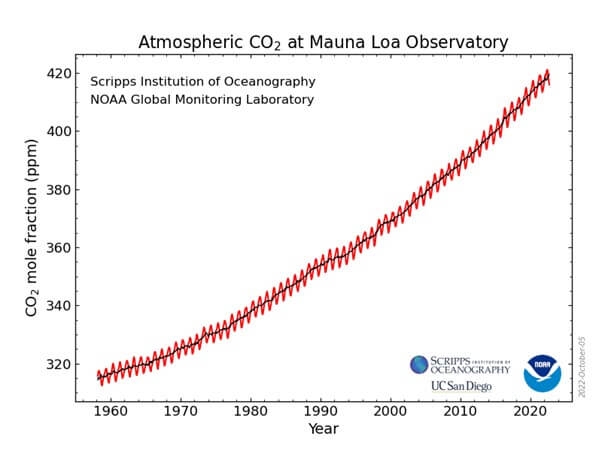
You can see the CO2 concentration has been increasing ever since the measurements started. It was 316 ppm in 1958, 327 ppm when I was born in 1971, 385 ppm in 2007 when my twins were born, and 416 ppm in September 2022. See if you can use the graph to work out what the CO2 concentration was when you were born. There’s an interactive version here: https://gml.noaa.gov/ccgg/trends/graph.html
Over time scientists began to make measurements at more places around the world, including in Tasmania. This graph shows CO2 concentration at Cape Grim since 1984:
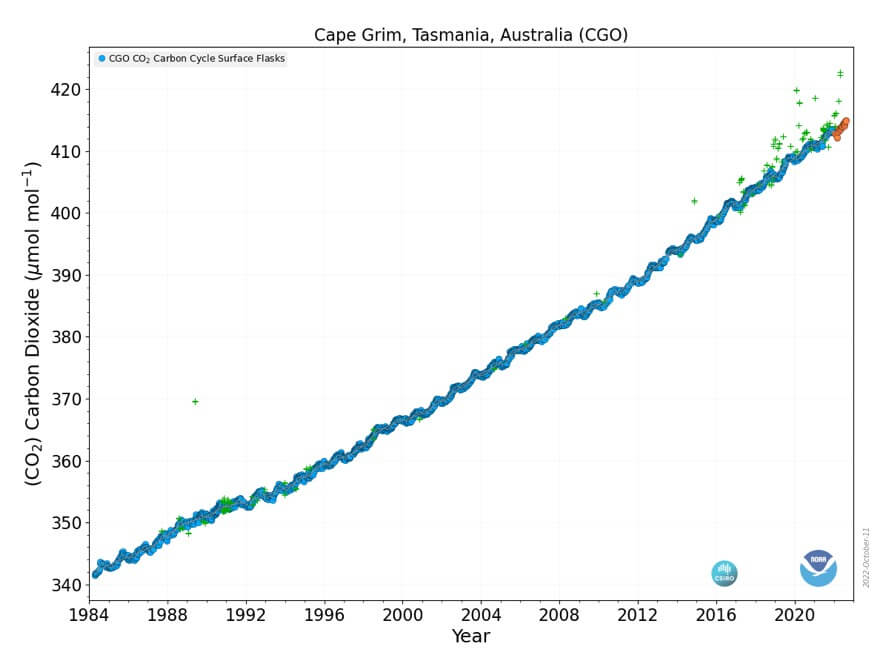
Finally, we even know how gases changed before scientists started collecting samples from mountains. This information comes from bubbles trapped in ice cores, which preserve the air that was around at the time the ice formed. The oldest of these ice samples are 800 thousand years old! The graphs below, from the IPCC 6th Assessment Report, show greenhouse gas concentrations going back 800,000 years. The data on the right-hand side, showing ‘ambient air’, is from flasks like in the graphs above.
What you can see from these graphs is that
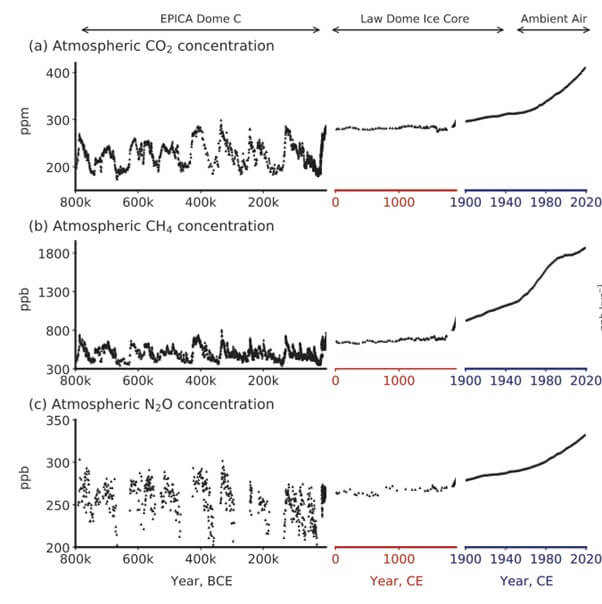
There is a great animation available on youtube that shows how CO2 in the atmosphere has changed.